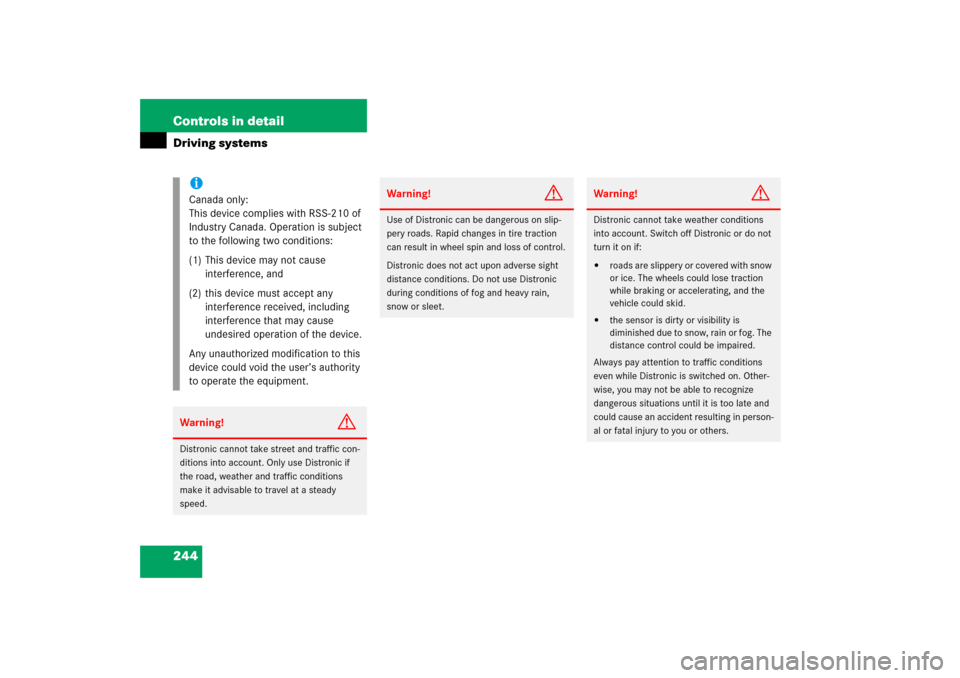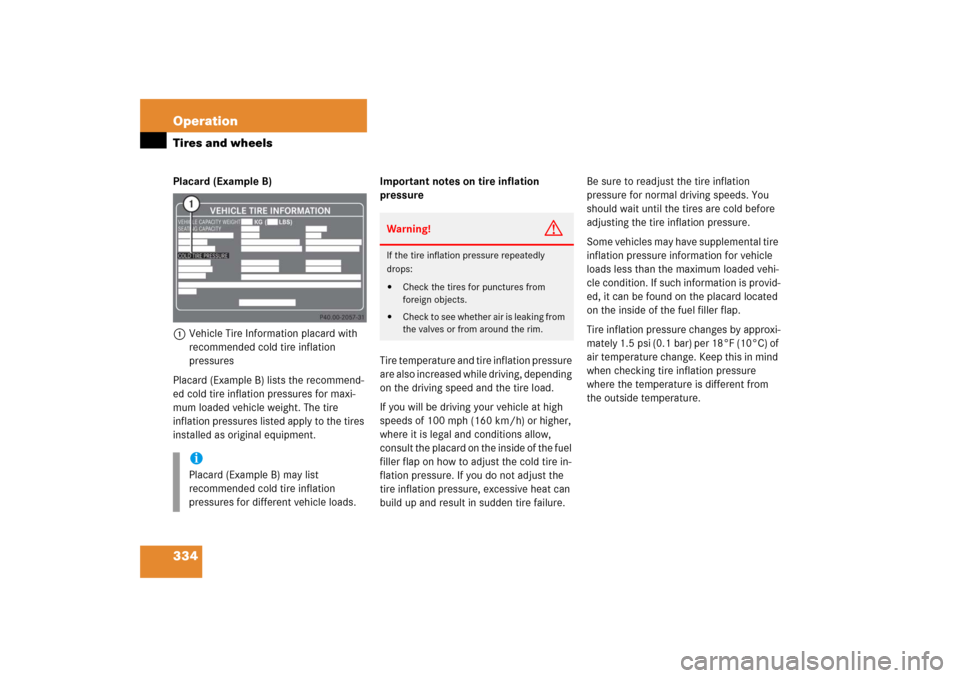Page 240 of 521

239 Controls in detail
Driving systems
�Driving systems
The driving systems of your vehicle are de-
scribed on the following pages:�
Cruise control and Distronic*, with
which the vehicle can maintain a preset
speed
�
Airmatic DC* adjusts the vehicle sus-
pension characteristics automatically
and controls the vehicle level
For information on BAS, ABS, electrohy-
draulic brake system and ESP
® driving sys-
tems, see “Driving safety systems”
(
�page 91).
Cruise control
The cruise control automatically maintains
the speed you set for your vehicle.
Use of cruise control is recommended for
driving at a constant speed for extended
periods of time. You can set or resume
cruise control at any speed above 20 mph
(30 km/h).
The cruise control function is operated by
means of the cruise control lever.
The cruise control lever is the uppermost
lever on the left-hand side of the steering
column (
�page 22).
Warning!
G
The cruise control is a convenience system
designed to assist the driver during vehicle
operation. The driver is and must remain at
all times responsible for the vehicle speed
and for safe brake operation.
Only use the cruise control if the road, traffic
and weather conditions make it advisable to
travel at a steady speed.�
The use of cruise control can be danger-
ous on winding roads or in heavy traffic
because conditions do not allow safe
driving at a steady speed.
�
The use of cruise control can be danger-
ous on slippery roads. Rapid changes in
tire traction can result in wheel spin and
loss of control.
�
Deactivate the cruise control when driv-
ing in fog.
The “Resume” function should only be oper-
ated if the driver is fully aware of the previ-
ously set speed and wishes to resume this
particular preset speed.
Page 245 of 521

244 Controls in detailDriving systems
iCanada only:
This device complies with RSS-210 of
Industry Canada. Operation is subject
to the following two conditions:
(1) This device may not cause
interference, and
(2) this device must accept any
interference received, including
interference that may cause
undesired operation of the device.
Any unauthorized modification to this
device could void the user’s authority
to operate the equipment.Warning!
G
Distronic cannot take street and traffic con-
ditions into account. Only use Distronic if
the road, weather and traffic conditions
make it advisable to travel at a steady
speed.
Warning!
G
Use of Distronic can be dangerous on slip-
pery roads. Rapid changes in tire traction
can result in wheel spin and loss of control.
Distronic does not act upon adverse sight
distance conditions. Do not use Distronic
during conditions of fog and heavy rain,
snow or sleet.
Warning!
G
Distronic cannot take weather conditions
into account. Switch off Distronic or do not
turn it on if:�
roads are slippery or covered with snow
or ice. The wheels could lose traction
while braking or accelerating, and the
vehicle could skid.
�
the sensor is dirty or visibility is
diminished due to snow, rain or fog. The
distance control could be impaired.
Always pay attention to traffic conditions
even while Distronic is switched on. Other-
wise, you may not be able to recognize
dangerous situations until it is too late and
could cause an accident resulting in person-
al or fatal injury to you or others.
Page 258 of 521
257 Controls in detail
Driving systems
Select the “Raised” level only when re-
quired by current driving conditions. Oth-
erwise�
handling may be impaired
�
fuel consumption may increaseiThese height adjustments are so small
that you may not notice any change.Warning!
G
To help avoid personal injury, keep hands
and feet away from wheel housing area, and
stay away from under the vehicle when low-
ering the vehicle chassis.
Page 335 of 521

334 OperationTires and wheelsPlacard (Example B)
1Vehicle Tire Information placard with
recommended cold tire inflation
pressures
Placard (Example B) lists the recommend-
ed cold tire inflation pressures for maxi-
mum loaded vehicle weight. The tire
inflation pressures listed apply to the tires
installed as original equipment.Important notes on tire inflation
pressure
Tire temperature and tire inflation pressure
are also increased while driving, depending
on the driving speed and the tire load.
If you will be driving your vehicle at high
speeds of 100 mph (160 km/h) or higher,
where it is legal and conditions allow,
consult the placard on the inside of the fuel
filler flap on how to adjust the cold tire in-
flation pressure. If you do not adjust the
tire inflation pressure, excessive heat can
build up and result in sudden tire failure.Be sure to readjust the tire inflation
pressure for normal driving speeds. You
should wait until the tires are cold before
adjusting the tire inflation pressure.
Some vehicles may have supplemental tire
inflation pressure information for vehicle
loads less than the maximum loaded vehi-
cle condition. If such information is provid-
ed, it can be found on the placard located
on the inside of the fuel filler flap.
Tire inflation pressure changes by approxi-
mately 1.5 psi (0.1 bar) per 18°F (10°C) of
air temperature change. Keep this in mind
when checking tire inflation pressure
where the temperature is different from
the outside temperature.
iPlacard (Example B) may list
recommended cold tire inflation
pressures for different vehicle loads.
Warning!
G
If the tire inflation pressure repeatedly
drops:�
Check the tires for punctures from
foreign objects.
�
Check to see whether air is leaking from
the valves or from around the rim.
Page 355 of 521
354 OperationTires and wheelsFor information on wheel change, see the
“Practical hints” section (
�page 422) and
(
�page 445).Warning!
G
Have the tightening torque checked after
changing a wheel. Wheels could become
loose if not tightened with a torque of
96 lb-ft (130 Nm).
Only use Genuine Mercedes-Benz wheel
bolts specified for your vehicle’s rims.
Page 414 of 521
413 Practical hints
What to do if …
Display symbol
Display messages
Possible cause/consequence
Possible solution
H
Please rectify
tire pressure
The pressure is too low in one or
more tires.
�
Check and correct tire inflation pressure as
required (
�page 335).
Tire pressure
Caution, tire defect
One or more tires are deflating.
�
Carefully bring the vehicle to a halt, avoiding
abrupt steering and braking maneuvers.
�
If necessary, change the wheel (
�page 445).
Tire pressure
Check tires
The tire pressure in one or more
tires is already below the mini-
mum value.
�
Carefully bring the vehicle to a halt, avoiding
abrupt steering and braking maneuvers.
�
Check and adjust tire pressure as required.
�
If necessary, change the wheel (
�page 445).
Warning!
G
Do not drive with a flat tire. A flat tire affects
the ability to steer or brake the vehicle. You
may lose control of the vehicle. Continued
driving with a flat tire will cause excessive
heat build-up and possibly a fire.
Page 422 of 521

421 Practical hints
Where will I find ...?
Vehicle tool kit (vehicles with TIREFIT)
1Vehicle tool kit and jack
2Electric air pump
3TIREFIT kitVehicle jackThe vehicle jack is located in the cargo
compartment underneath the third row
seat cushions and footwell (
�page 420) or
underneath the cargo compartment floor
(
�page 419).
Storage position�
Remove vehicle jack from its
compartment.
�
Turn crank handle in direction of arrow
as far as it will go.
Warning!
G
The jack is designed exclusively for jacking
up the vehicle at the jack take-up brackets
built into both sides of the vehicle. To help
avoid personal injury, use the jack only to lift
the vehicle during a wheel change. Never
get beneath the vehicle while it is supported
by the jack. Keep hands and feet away from
the area under the lifted vehicle. Always
firmly set parking brake and block wheels
before raising vehicle with jack.
Do not disengage parking brake while the
vehicle is raised. Be certain that the jack is
always vertical (plumb line) when in use,
especially on hills. Always try to use the jack
on level surface. Make sure the jack arm is
fully seated in the jack take-up bracket.
Always lower the vehicle onto sufficient
capacity jackstands before working under
the vehicle.
Page 423 of 521

422 Practical hintsWhere will I find ...?Operational position�
Turn crank handle clockwise.
Before storing the vehicle jack in its
compartment:
�
It should be fully collapsed.
�
The handle must be folded in (storage
position).Spare wheel
If your vehicle is equipped with a spare
wheel (Minispare or collapsible tire), it is
located in the cargo compartment under-
neath the third row seat cushions and foot-
well (
�page 420) or underneath the cargo
compartment floor (
�page 419). To ac-
cess the spare wheel, fold seat cushions
and footwell up (
�page 420).
1Vehicle tool kit
Wheel bolt wrench and Jack
2Spare wheel
3Luggage bowlRemoving the spare wheel
�
Turn luggage bowl3 counterclock-
wise.
�
Remove spare wheel2.
Storing the spare wheel
�
Place spare wheel2 in wheel well.
�
Turn luggage bowl3 clockwise to its
stop to secure the spare wheel.Warning!
G
The dimensions of the spare wheel
(Minispare or collapsible tire) are different
from those of the road wheels. As a result,
the vehicle handling characteristics change
when driving with a spare wheel mounted.
The Minispare wheel and collapsible tire
should only be used temporarily, and re-
placed with a regular road wheel as quickly
as possible.